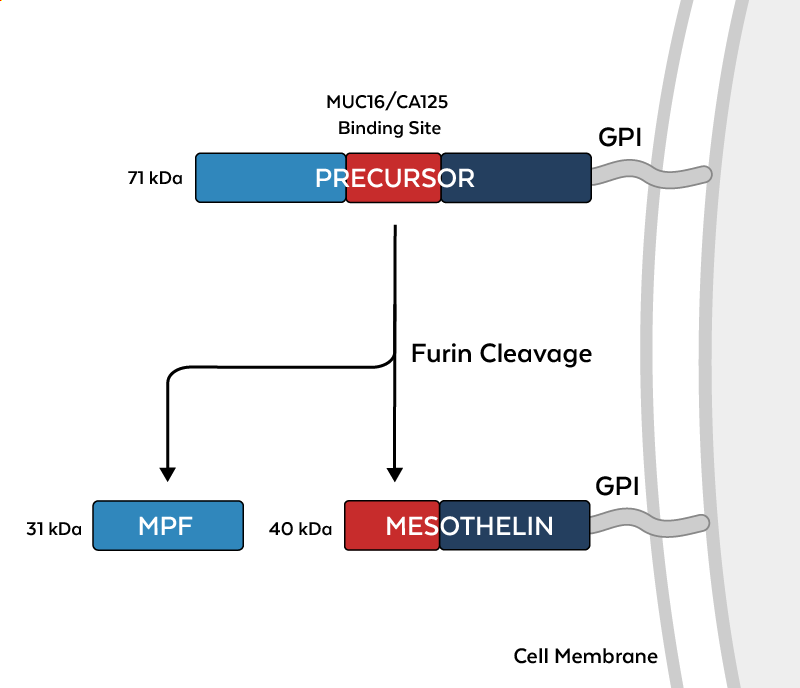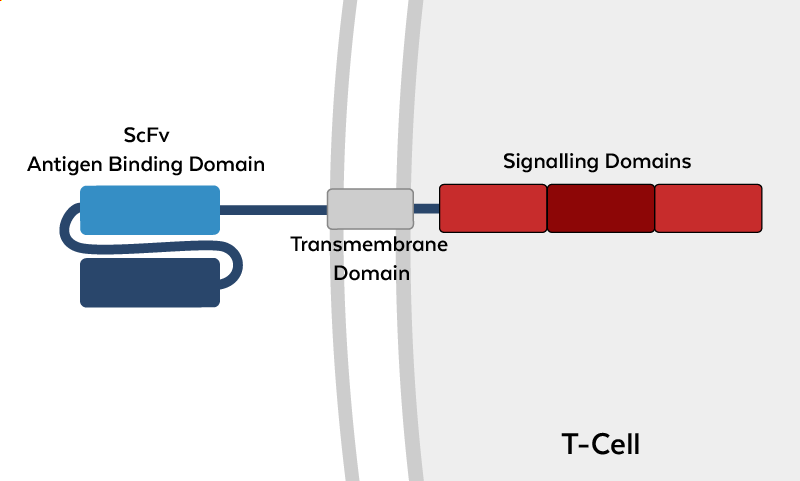Modern targeted cancer therapies hinge upon the overexpression of tumor-associated antigens, exhibiting minimal to negligible expression in normal cells. Within the realm of novel immunotherapies, Mesothelin (MSLN) has emerged as a promising target. MSLN is a tumor-associated antigen (TAA) that is highly expressed in various cancers including, malignant mesothelioma, ovarian cancer, breast cancer, pancreatic cancer, lung cancer, gastric cancer, endometrial cancer, cervical cancer, biliary cancer, uterine serous carcinoma, cholangiocarcinoma, and pediatric acute myeloid leukemia. In fact, MSLN appears to be overexpressed in almost a third of all cancers.1
More than two decades ago, researchers at the National Cancer Institute (NCI) in Bethesda, MD isolated and characterized a monoclonal antibody called K1.2 This antibody demonstrated reactivity not only with human ovarian carcinoma cells but also with normal mesothelium. The target of this antibody was later identified and named mesothelin after its natural occurrence. The precursor of MSLN is a 71 kDa glycoprotein that undergoes enzymatic cleavage, resulting in the release of two fragments: the 31 kDa megakaryocyte potentiating factor (MPF), and the 40 kDa GPI-anchored mesothelin protein (see Figure 1).
Despite numerous studies, the function of MSLN in tumors as well as in the mesothelium is elusive. There is evidence that MSLN acts as a lectin and binds carbohydrates in the extracellular matrix to the cell surface. Interactions between MSLN and MUC16/CA125 also suggest that mesothelin contributes to the control of cellular proliferation, growth processes, and signaling related to adhesion.3 However, as MSLN has no intracellular binding domain, it cannot act as a classical oncogene. For a detailed discussion on MSLN function and available literature, see Hagerty & Takabe, 2023.

Mesothelin Products
| Product | Clonality | Reactivity | Applications |
| Mesothelin Antibody | Monoclonal | Human | WB, IHC, FC |
| Mesothelin Antibody | Monoclonal | Human | WB, IHC, FC |
| Human Mesothelin ELISA Kit | - | Human | ELISA |
Despite its unclear function, MSLN has become one of the most important targets in the battle against solid tumors. Strategies include antibodies, antibody-drug conjugates (ADCs), immunotoxins, cancer vaccines, and Chimeric antigen receptor (CAR) T-cell immunotherapies.
CAR T-cell therapy is one of the most promising new forms of therapy for the treatment of cancer that involves modifying a patient's T-cells, to better target and attack cancer cells. A CAR comprises an antibody-based fragment that identifies the target, a spacer that connects to a transmembrane domain, and an intracellular domain that triggers T-cell activation (see Figure 2). In November 2023, 45 clinical MSLN CAR trials were registered on the clinicaltrials.gov website. Out of the 45 trials listed, 7 were in early phase I, 33 in phase I, and 11 in phase II. However, challenges remain, including potential side effects like cytokine release syndrome (CRS), neurotoxicity, and off-target effects. To date, clinical trials with anti-MSLN CAR T-cells have shown a high safety profile but limited anti-tumor efficacy.5
Antibody-drug conjugates (ADCs) allow for targeted drug delivery to the tumor cell and thus reduce the risk of off-target effects. An ADC directed against mesothelin, Anetumab ravtansine (BAY94–9343), was used to treat preclinical cancer models, including pancreatic cancer. This ADC consists of a human anti-mesothelin antibody conjugated to the maytansinoid tubulin inhibitor DM4. It led to a temporary regression of the tumors and was superior to the standard treatment.6 A different study highlighted anetumab ravtansine for ovarian cancer treatment and showed its suitability for combination therapy with other antitumor agents.7 However, there are no approved MSLN targeting ADCs to date.

Several phase I and phase II studies have been conducted with a chimeric monoclonal antibody targeting MSLN named Amatuximab (MORAb-009) which consists of a single-chain fragment variable (scFv) domain fused to human IgG1/κ. While the phase I studies confirmed the antibody's strong safety profile, the results of the phase II studies have not yet been convincing. Although no improvement in progression-free survival was observed in a combination study, the median overall survival time was better than in historical controls.8 Further research is needed to improve the effectiveness of antibody-based MSLN immunotherapies. Rockland's MSLN products can help you move your projects forward.
Featured Publications
For over 10 years, Rockland's mesothelin antibodies have been helping to advance the different lines of mesothelin immunotherapy. Take a glance at this sample selection of publications:
Mesothelin/CD3 half-life extended bispecific T-cell engager molecule shows specific tumor uptake and distributes to mesothelin and CD3 expressing tissues.
Suurs FV et al. (2021)
J Nucl Med.In this publication, Rockland's 200-301-A88 was used for bispecific antibody generation (BiTE®).View on PubMed
Combining Local Immunotoxins Targeting Mesothelin with CTLA-4 Blockade Synergistically Eradicates Murine Cancer by Promoting Anticancer Immunity.
Leshem, Y et al. (2017)
Cancer Immunology ResearchIn this publication, Rockland's 200-301-A88 was used for flow cytometry analysis.View on PubMed
Efficacy of RG7787, a next-generation mesothelin-targeted immunotoxin, against triple-negative breast and gastric cancers.
Alewine, C et al. (2014)
Molecular Cancer Therapeutics
In this publication, Rockland's 200-301-A88 was used for immunohistochemistry. View on PubMed